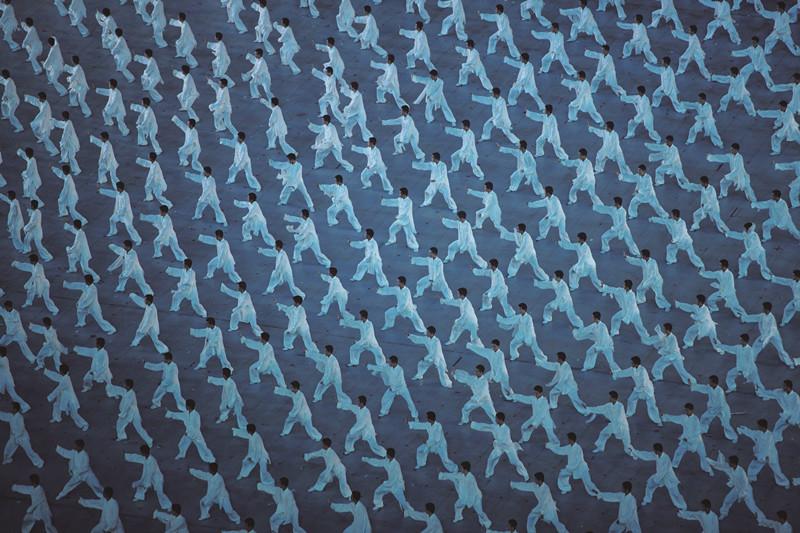
 Old Version
Old Version
Tai Chi vs MMA
Chinese martial artists, like the kungfu monks of Shaolin Temple, are adored around the world, as much as a part of popular culture as unparalleled fighters, cloaked in a mantle of myth. However, their ancient fighting tradition is threatened by the new.
The trouncing of a self-proclaimed tai chi master by an MMA fighter (Mixed Martial Arts, a more modern discipline that blends various combat styles) has brought traditional martial arts back into the limelight. Competing for territory in the harsh jungle with Brazilian jiujitsu, muay thai, MMA and submission wrestling, Chinese martial arts have been criticized for losing their combative edge in the modern era.
Every ancient tradition has to face the problems of modernity. The Chinese martial arts, also known collectively as wushu or referred to as kungfu, focus on the patient process of honing skills and cultivating virtues without necessarily having the goal of winning. Yet this values system has been increasingly challenged by the fast, effective, ultra competitive modern martial arts culture worldwide.
In a clash of tradition and modernity, and during a process of government-led standardization and commercialization, the ancient fighting arts are still feeling their way.
Martial arts in China were born of the same reasons as in every other culture: to defeat opponents and defend against threats in hunting, fighting and war.
China’s martial arts have their origins in the Shang and Zhou Dynasties (1600 to 256BC). During the following Qin (221 - 207BC) and Han (202BC - 220AD) Dynasties, wrestling, swordplay and spear skills became highly developed and were popular among civilians and troops. In the Song Dynasty (960-1279AD), various schools, boxing styles, movement sets and weapon skills flourished.
Chinese combative arts have been heavily influenced by Chinese culture and philosophy, especially by Taoism, Confucianism and Buddhism. The key Taoist concepts of Yin and Yang (the universal opposites) and the Bagua (Eight Trigrams) were adopted to create the “hard and soft” and “swift and slow” techniques and strategies.
As a highly varied martial arts system, Chinese wushu has over 400 sub-styles. The northern styles, such as Shaolin kungfu, focus more on kicks and adopting wide stances, while the southern styles put more emphasis on using the hands and narrower stances.
Most fighting styles that are practiced as traditional Chinese martial arts today enjoyed widespread popularity in the 20th century, including the gloriously named Bagua Palm, Drunken Boxing, Eagle Claw, Five Animals, Xinyi Fist, Monkey Fist, Northern Praying Mantis, Wing Chun and many more.
Originally, martial arts were an elite art practiced by the few. In the transition period between the fall of the Qing Dynasty in the early 1900s as well as the turmoil of the Japanese invasion and Chinese Civil War from the 1920s to 1940s, martial arts experts were encouraged to open their doors and teach the general public in an effort to expel foreign invaders. Martial arts were deemed a means to promote national pride.
Since the founding of the People’s Republic of China in 1949, wushu has undergone fundamental changes. In 1958, the government established the All-China Wushu Association to regulate martial arts training. The Chinese State Commission for Physical Culture and Sports took the lead in creating standardized forms for most of the major arts. Wushu has been transformed into a standardized modern competition sport, which consists of taolu forms and sanda sparring.
Taolu forms involve martial arts patterns and maneuvers for which competitors are judged and assigned points according to specific rules. It’s an impressive combination of gymnastics, agility and body mastery.
Sanda, which was developed in the 1980s, is a modern fighting method and sport derived from traditional Chinese boxing (sanshou), wrestling (shuai jiao) and grappling techniques (qinna). It appears much like kickboxing or muay thai, but contains more grappling techniques.
Perhaps the most-discussed controversy in modern Chinese martial arts is whether they can be used in real fights.
A number of modern schools have substituted practical defense or attack skills with flashy movements that are more esthetically pleasing, thereby gaining favor during demonstrations and competitions. Some schools have even mixed wushu with moves from ballet and other disciplines, leaving it out of touch with its origins. Many traditional Chinese martial artists have been critical of attempts to move the art beyond the practicalities of combat.
“Fighting skills are the essence of traditional Chinese martial arts. From the perspective of etymology, the character wu, in early oracle bones inscriptions [the earliest examples of Chinese writing], consists of the pattern of a spear and a blade; shu means crafts and techniques. Thus, the word wushu initially means the crafts of fighting. If wushu loses its fighting techniques, it will be reduced to wudao, literally ‘dancing’,” said Wu Shijun, 72, the successor of the eleventh generation of Chen-style tai chi, and postgraduate tutor at the Martial Arts Department of the Beijing Humanities University.
As Wu indicated, the combative aspect of martial arts was discouraged after the founding of the People’s Republic in 1949. In 1952, Chairman Mao Zedong put forward the slogan “promote physical culture and sports; build up the people’s health.” To answer the call, the government started to transform traditional martial arts into a sport, emphasizing its purpose of exercise and physical wellbeing.
“Take tai chi for an example,” said Wu, “In 1956, the Chinese Sports Committee brought together four tai chi masters to create a simplified form of tai chi, ‘24-form tai chi quan’, as exercise for the public. Since then, tai chi has gradually become a way of maintaining fitness, especially welcomed by the middle-aged and elderly. Thus, the image of tai chi as a sport for the elderly has become rooted in people’s minds.
“To a certain extent, the government’s promotion has diverted martial arts away from its own course. The overemphasis on the element of exercise means this part has suppressed the fighting value, and real kungfu is being forgotten,” Wu told NewsChina.